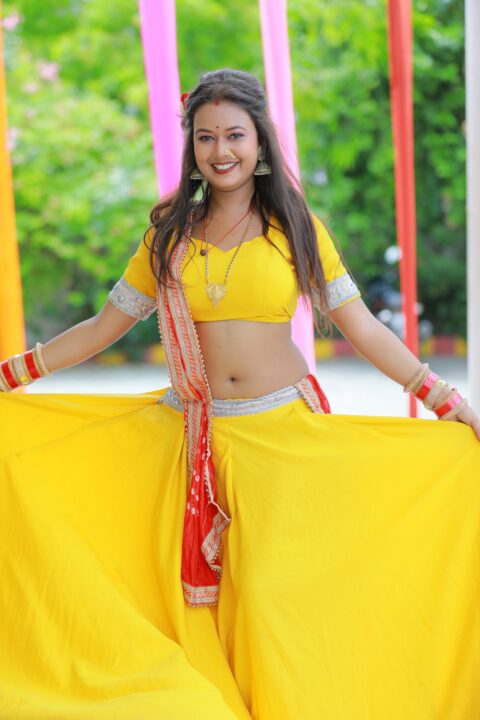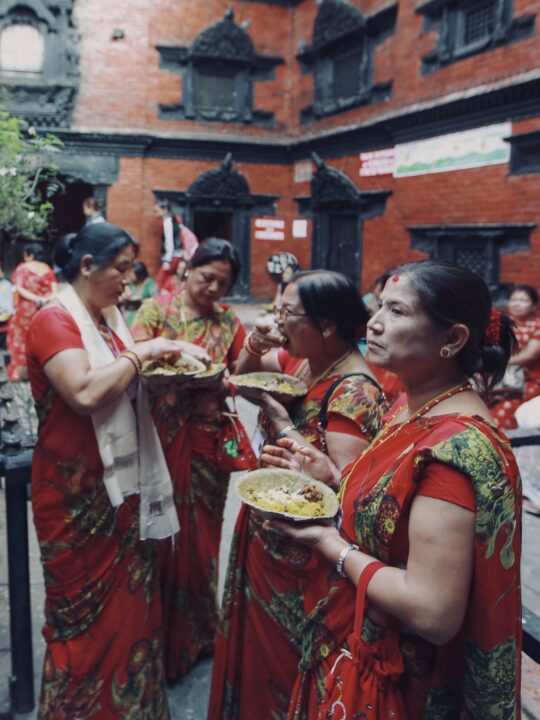Nepal is a multicultural, multi-religious, multiethnic, and multilingual country. Situated close to the Himalayan Mountains, halfway between China and India, It is one of the least developed nations in Asia. The tallest mountain, Mount Everest, is found in the country.
In Nepal, there are different ethnic groups, each with its own distinctive clothing. The vast and diverse cultures of Nepal are reflected in the brilliant colors and exquisite designs of these traditional garments. The most popular Nepali traditional clothing is the “Gunyo Cholo” for women and the “Daura Suruwal” for men.
Although it’s difficult to estimate the amount of clothing in the nation, It is safe to say that Nepali traditional dress comes in vast diversity. Additionally, each of these outfits pays homage to the ethnic group’s cultural background.
Dress Specifications According To Ethnicity
Dressing in your traditional attire has its benefits. For example, it can help you express your appreciation for your traditions and culture. Additionally, it might assist you in reconnecting with the customs and cultures of your ancestors.
Because of this, the majority of the citizens enjoy dressing in Nepali traditional clothing. Nepal is a multiethnic country with more than 100 different ethnic groups. And that’s a reason for the abundance of traditional clothing.
People of Nepal’s many ethnicities wear a variety of jewelry and clothing that is specific to them and distinguishes them from other ethnicities. Bahun, Chhetri, Gutung, Limbu, Magar, Maithili, Newar, Raute, Rai, etc. are only a few examples of the various castes, and the attire they wear differs in little ways from the attire of other castes.
The nation’s traditional clothing displays a slight fusion of their multiethnicity and religious practices like Buddhism and Hinduism. On different occasions, such as festivals, marriages, and religious rituals, Nepalese people also dress traditionally.
In addition to displaying their culture, this attire helps to protect their heritage. At times, these clothes serve as a form of protection from hot or cold weather. Some Nepalese that live in the highlands have specific clothing that aids them in climbing high mountains or enduring harsh weather.
10 Nepalese Traditional Clothing
1. Sari

The sari is a long piece of cloth material wrapped around the waist and worn with a blouse. In Nepal, it is the most typical outfit for women. Each area in Nepal has its own version of the sari, which comes in a variety of fabrics, patterns, and hues. The Dhaka sari, which consists of cotton or silk and contains elaborate motifs, is the most well-known type of sari.
Saris is a versatile and lovely traditional clothing option for a variety of situations, from daily wear to special occasions like weddings. They are available in a broad variety of colors, fabrics, and designs. The sari is a feature of the country’s traditional clothing culture, especially among women in distinct communities.
2. Daura Suruwal
A Daura suruwal serves as the men’s version of Nepal’s traditional garb. It comprises a loose-fitting pair of trousers (suruwal) and a knee-length shirt. Usually, it is used for formal events like weddings and other ceremonies. There are two key parts to it:
The Daura is a long shirt that has five pleats that are symbolic and stand for earth, water, fire, air, and ether. The Daura is a distinctive closed-neck garment with ties that are typically buttoned up the top. The Suruwal is another part of the outfit. It is suitable for daily tasks because it is cozy and easy to move around in.
The Daura Suruwal consists of 8 strings (since 8 is considered to be a lucky number according to the Nepalese people). It refers to Astamatrika-Singini, which is as follows:
- Biagini
- Kumari
- Barahi
- Brahmayani
- Indrayani
- Maheshwari
- Byasnabi
- Mahalaxmi
3. Kurta Suruwal
Kurta suruwal is another Nepali traditional garment worn by women in Nepal. It consists of a long shirt (kurta) and loose-fitting trousers (suruwal). The kurta suruwal is comfortable to wear and is perfect for everyday wear. Women also wear the kurta suruwal on formal occasions such as weddings and other ceremonies.
It has two constituents: first, the kurta, a long and comfortable top that resembles a tunic and is frequently below the knees in length. It is frequently worn with a Suruwal, which is the outfit’s foundation. It is a pair of jeans or a not-too-tight attire with a waistband gathering. The Suruwal is flexible and suitable for a variety of activities.
The Kurta Suruwal is an adaptable traditional garment that can be worn on special occasions as well as in everyday settings. Based on regional and individual preferences, Kurta Suruwal’s design, fabric, and colors might change.
4. Gunyo Cholo
Women in Nepal wear this traditional Gunyo Cholo clothing more often. It comprises a long skirt (gunyo) and a tight blouse (cholo). Women wear it at festivals and other events, frequently coupled with a shawl.
This is Daura Suruwal’s female equivalent attire. And alongside being the national garment of Nepal, the gunyou cholo has special importance. It is offered to a girl who is 7 or 8 years old to commemorate the fact that she is steadily maturing into a woman and to mark the beginning of her femininity.
It comprises a skirt and cholo, both embellished with a lot of jewelry. Unfortunately, Daurya Suruwal and Gunyou Cholo were both disqualified from functioning as the national dresses of Nepal after the political revolution in 2011. They are still only used as traditional Nepali clothing.
5. Dhaka Topi
The Dhaka topi serves as a typical cap worn by males in Nepal. It consists of handwoven Dhaka fabric that is manufactured in Nepal. The Dhaka topi is worn at formal events like weddings and other festivities and is available in a range of colors and styles.
Nepali men can relate to their culture and display their cultural roots by wearing a Dhaka topi. It acts as an emblem of both national pride and traditional clothing.
Nepali males commonly wear the Dhaka topi for important events, including weddings, festivals, and cultural gatherings. It is regarded as an embodiment of Nepali pride and identity.
6. Dhoti
The Dhoti cloth is day-to-day dress attire. It’s as important as every other Nepali traditional garment. The attire has a soothing feature that suits the weather. Men who live in Nepal’s warmer regions, where wearing comfortable clothing is crucial, frequently wear the dhoti. In essence, it is a long, plain piece of clothing that men wear instead of pants, wrapping it around their hips and tying it at the waist.
It comprises a long cloth strip that is normally wrapped around the waist and fastened with a knot. A dhoti can be worn in a variety of ways, each with its own regional peculiarities and specialty.
When men wear the dhoti, it’s referred to as Dura” or “Gunyo”, but is referred to as “Gunyu Cholo” when worn with a blouse for women. It is frequently worn on holy days, festivals, and special occasions. The dhoti is well renowned for its simplicity and ease, making it appropriate for a warm climate.
7. Lungi

The sole reason for wearing lungis like some other attire is for comfortability. But also, men can wear the lungi as a long form of skirt, with one end remaining open and the other sewed. When performing daily tasks, both at home and in public, lungis are frequently worn. They are a practical option for casual clothing and are particularly well-liked among males.
Although there are regional and community variations in how a lungi is tied and worn, it is nonetheless a useful and important piece of clothing in the everyday lives of most males of Nepali origin.
8. Sherpa Dress
The Sherpa outfit is worn by the Sherpa people. The Sherpa people are known for mountain climbing, hence the need to wear a dress, which helps them daily because of climate change. The sherpa dress can be worn only for special occasions or daily, depending on the region.
Sherpa women wear inner pants over a long shirt called Wan-ju. And also a Bakhu around their waist and a red pangden for married women alone. While the gyaptil, or matil, is worn by both married and single ladies,
Sherpa women wear jewelry made of gold and pearls from their necks to their ears, such as dhungri and kaou (made of precious stone). In most cases, the female’s dresses are not complete until they wear a neat cap called the shyamu.
9. Sikkimese Bhaku
Mens Bhaku is Nepali traditional clothing worn by the Bhutia, the ethnic Sikkimese people of Sikkim. The Bhaku is a two-piece outfit typically consisting of a full-sleeved blouse and a wrap-around skirt.
The Sikkimese Bhaku is also, like some others, worn during festivals, festivities, and cultural events and represents the rich cultural heritage of Sikkim. The Bhaku is an amazing traditional garment because of its elaborate embroidery and vivid colors.
The blouse, referred to as “Hingcha,” often has colorful embroidery and is normally full-sleeved attire. Apparel is knotted around the waist, which runs the length of a skirt called “Kho.” Additionally, there is jewelry, such as necklaces and earrings, for accessories.
10. Tamang Dress
The Tamang dress is traditional Nepali clothing worn by the Tamang ethnic group. One of Nepal’s indigenous groups, the Tamangs, is known for its bright and extravagant decorations on traditional garments. The Tamang dress is characterized by differences in form based on the gender wearing it.
The Gunyu is the traditional Tamang dress solely for women. Consisting of a long and colorful dress with sparkling embroidery. It has the Fariya, which is normally tied around the waist to complement the Gunyu. A headscarf referred to as “Gunfu” is worn to complement the Tamang outfit. While the men wear an embroidered shirt with a long shirt called the phariya,
Evolution In Traditional Clothing
Although Western transformations in the fashion world are widespread, the people of Nepal still place great value on their traditional clothing. That does not rule out the fact that most recently, the Nepalese have started incorporating western dress patterns into their traditional attire.
Generally, the traditional attire of some countries is gradually vanishing as Western styles are gradually taking over. Additionally, it’s also tough to find some traditional clothing in stores and shops, hence either no production or buyers.
That being said, it’s imperative. I also add that we need to buckle up and learn to appreciate our traditional outfits. More value should be placed on traditional clothing than on Western clothing collections.
Final Words
In summary, traditional clothing is a fundamental component of Nepalese culture. It shows the rich heritage of the culture and traditions of the country. Every traditional garment, ranging from the sari to the daura suruwal, has its own special significance and symbolism. And although modern ideas have surfaced, Nepalese traditional clothing can still be preserved.



